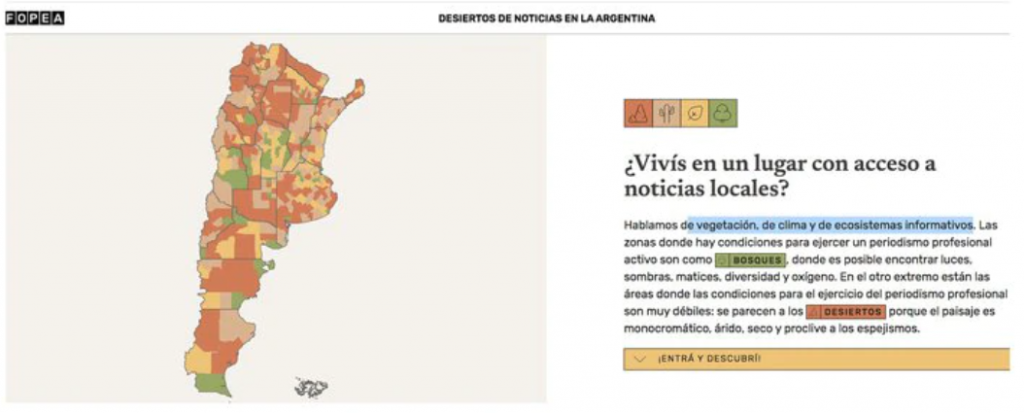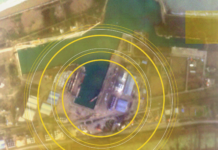The Argentine Journalism Forum (FOPEA) and Google News Initiative worked in an alliance where they presented a radiography of the information regions throughout the country. In more than 70% of the localities the conditions to practice local journalism are very weak and there is much dependence on Buenos Aires.

«The whole country wakes up with the news of whether or not the subway is running in the city of Buenos Aires,» says Fernando Ruiz, president of FOPEA. What about local news? What about local media? What about good journalistic practices? On all this, FOPEA and Google News Initiative conducted an in-depth research with the aim of detecting the red areas of Argentina where «situations are extremely weak for the practice of professional journalism, or where it has failed to develop in a stable manner».
To begin with, the study defined four categories. On the one hand, there are information deserts and semi-deserts, which are considered «areas where there is no media or where those that exist exhibit an extreme dependence on power -in its different manifestations-, or great precariousness, and, therefore, there are no conditions for the exercise of local journalism or it is extremely weak».
On the other hand, semi-forests and informative forests. In the latter case, these are considered to be areas with reasonable conditions for the practice of professional journalism. However, in Argentina only 9.8% of the territory falls into the latter category, and 17.1% into semi-forests.
According to the report published by FOPEA and Google News Initiative, the results show that in the 24 Argentine jurisdictions, there is a total of 47.9% of news deserts and 25.2% of semi-deserts. «This research incorporates Argentina among the countries in the world that have identified ‘zones of silence’ in order to implement measures to promote journalism and prevent deterioration», says the research.
The percentages of deserts, semi-deserts, semi-forests and informative forests in Argentina (Source: FOPEA).
Ranking of provinces
According to the study, La Rioja has the highest percentage of informative deserts with 81.5%, while it has 5.6% of informative forests. Next in the list is Santiago del Estero with 75% of local news deserts and 3.7% of news forests. Among the 10 provinces with more news deserts are also: Formosa, Tucumán, Misiones, San Juan, Jujuy, Salta, La Pampa and Santa Cruz.
The province with the highest percentage of informative forests is Mendoza with 27.8% and 11.1% of informative deserts (the lowest in the country). This is followed by Córdoba, with 26.9% of locations with informative forests and 15.4% of informative deserts. In addition, Río Negro is the third province with the highest percentage of informative forests, with 23.1%. However, it also presents 46.2% of informative deserts.
Here below all the details ????:
The 24 jurisdictions ordered according to the amount of local news deserts found in the respective territories (Source: FOPEA).
YOU CAN ALSO READ

Who do we trust the most to inform us about the pandemic: doctors and politicians at both extremes?
Between «clicks» and «clocks», the balance the media are aiming for
The Impact of Information Deserts on Democracy
«This study helps us to promote better information and, therefore, better democracy,» explains Fernando Ruiz. He adds: «In the United States it has been studied that in an area with a journalistic desert, citizens are less informed, the costs of state management are more expensive and fewer people go to vote. All these problems for democracy are enhanced in Latin America».
«In Argentina’s democracy, many people live under local dictatorships. Let’s look at the case of the AMBA: millions of people live in municipalities that have very bad local press coverage. In our country, I believe that one of the most profound effects is that the weakness of the local press reinforces the unitarism in the journalistic ecosystem. The preeminence of the Buenos Aires bubble is absolute», adds the professor of the School of Communication of Universidad Austral.
News deserts in Argentina (Source: FOPEA).
What are the solutions to put an end to news deserts?
Ruiz lists a series of measures taken by FOPEA to promote good journalistic practices and combat the problem of deserts. «It is necessary to find sources of financing for the local press. Three quarters of the country’s departments do not have it or it is very precarious, which represents almost 20 million people», he begins.
And it continues: «FOPEA proposes to think of a transparency clause that applies to the most important public contracts that are made in those departments, whether they are from the municipality, the province or the nation. This means that the contractor has to buy space in the local press to report on the contract. Several of the main law firms in Latin America have helped us to prepare this proposal».
He also says that FOPEA carries out training sessions with increasing capillarity, trying to reach the territory in a more precise way. In line with this initiative, he assures that the team has just launched three guides for the development of the local press.
The big question is: what solutions have other countries adopted? Ruiz points out: «The concern is global and there are no saving initiatives. Even so, countries like Colombia and Brazil are promoting training. In the United States, an attempt was made in Congress to create a commission to study the issue, but no one voted for it.»
«As always, something serious has to happen to raise awareness and activate public policies,» he concludes.
All the details of the investigation
The research led by FOPEA and Google News Initiative began in December 2020 in the province of Tucumán, where it lasted until the end of January 2021. In the remaining 23 jurisdictions, the study began in February and ended in March 2021.
What was the methodology? A team of 27 researchers from all over the country managed a digital form composed of 26 questions. «The questionnaire was assembled based on a previous analysis of research on information deserts developed in countries where the study and identification of the phenomenon is more advanced, such as Brazil, Venezuela, Colombia, Mexico, Canada and the United States,» explained the fopea.org website.
The study detected 2,464 media and 13,597 journalists. Although this is an immense universe, it is not the total universe, so it does not correspond to a census.
«This is a historical reality of which for the first time we can take an accurate picture,» says Fernando Ruiz. It is time to take advantage of this research and take action.





